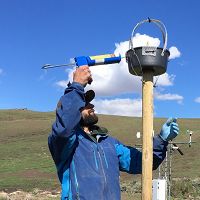Vega et al. 2019
Interaction of wind and cold‐season hydrologic processes on erosion from complex topography following wildfire in sagebrush steppe
Vega, S.P., Williams, C.J., Brooks, E.S., Pierson, F.B., Strand, E.K., Robichaud, P.R., Brown, R.E., Seyfried, M.S., Lohse, K.A., Glossner, K., Pierce, J.L., C. Roehner (2019)
Earth Surface Processes and Landforms
-
Reynolds, GRAD STUDENT
-
Reynolds, INVESTIGATOR
-
Reynolds, INVESTIGATOR
-
Reynolds, GRAD STUDENT
-
Reynolds, INVESTIGATOR
-
Reynolds, GRAD STUDENT
Abstract
Wildfire is a natural component of sagebrush (Artemisia spp.) steppe rangelands that induces temporal shifts in plant community physiognomy, ground surface conditions, and erosion rates. Fire alteration of the vegetation structure and ground cover in these ecosystems commonly amplifies soil losses by wind‐ and water‐driven erosion. Much of the fire‐related erosion research for sagebrush steppe has focused on either erosion by wind over gentle terrain or water‐driven erosion under high‐intensity rainfall on complex topography. However, many sagebrush rangelands are geographically positioned in snow‐dominated uplands with complex terrain in which runoff and sediment delivery occur primarily in winter months associated with cold‐season hydrology. Current understanding is limited regarding fire effects on the interaction of wind‐ and cold‐season hydrologic‐driven erosion processes for these ecosystems. In this study, we evaluated fire impacts on vegetation, ground cover, soils, and erosion across spatial scales at a snow‐dominated mountainous sagebrush site over a 2‐year period post‐fire. Vegetation, ground cover, and soil conditions were assessed at various plot scales (8 m2 to 3.42 ha) through standard field measures. Erosion was quantified through a network of silt fences (n = 24) spanning hillslope and side channel or swale areas, ranging from 0.003 to 3.42 ha in size. Sediment delivery at the watershed scale (129 ha) was assessed by suspended sediment samples of streamflow through a drop‐box v‐notch weir. Wildfire consumed nearly all above‐ground live vegetation at the site and resulted in more than 60% bare ground (bare soil, ash, and rock) in the immediate post‐fire period. Widespread wind‐driven sediment loading of swales was observed over the first month post‐fire and extensive snow drifts were formed in these swales each winter season during the study. In the first year, sediment yields from north‐ and south‐facing aspects averaged 0.99–8.62 t ha−1 at the short‐hillslope scale (~0.004 ha), 0.02–1.65 t ha−1 at the long‐hillslope scale (0.02–0.46 ha), and 0.24–0.71 t ha−1 at the swale scale (0.65–3.42 ha), and watershed scale sediment yield was 2.47 t ha−1. By the second year post fire, foliar cover exceeded 120% across the site, but bare ground remained more than 60%. Sediment yield in the second year was greatly reduced across short‐ to long‐hillslope scales (0.02–0.04 t ha−1), but was similar to first‐year measures for swale plots (0.24–0.61 t ha−1) and at the watershed scale (3.05 t ha−1). Nearly all the sediment collected across all spatial scales was delivered during runoff events associated with cold‐season hydrologic processes, including rain‐on‐snow, rain‐on‐frozen soils, and snowmelt runoff. Approximately 85–99% of annual sediment collected across all silt fence plots each year was from swales. The high levels of sediment delivered across hillslope to watershed scales in this study are attributed to observed preferential loading of fine sediments into swale channels by aeolian processes in the immediate post‐fire period and subsequent flushing of these sediments by runoff from cold‐season hydrologic processes. Our results suggest that the interaction of aeolian and cold‐season hydrologic‐driven erosion processes is an important component for consideration in post‐fire erosion assessment and prediction and can have profound implications for soil loss from these ecosystems.
Citation
Vega, S.P., Williams, C.J., Brooks, E.S., Pierson, F.B., Strand, E.K., Robichaud, P.R., Brown, R.E., Seyfried, M.S., Lohse, K.A., Glossner, K., Pierce, J.L., C. Roehner (2019): Interaction of wind and cold‐season hydrologic processes on erosion from complex topography following wildfire in sagebrush steppe. Earth Surface Processes and Landforms. DOI: https://doi.org/10.1002/esp.4778
Explore Further






